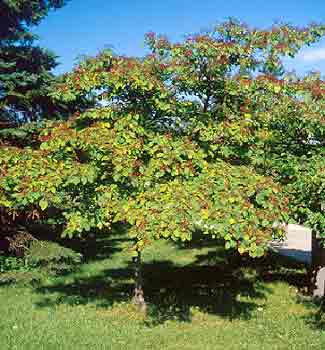 Pagoda Dogwood - Cornus alternifolia
Pagoda Dogwood - Cornus alternifolia
Dogwood Family (Cornaceae)
- Native habitat: New Brunswick to Minnesota, and south to Georgia and Alabama.
- Growth habit: Spreading, with horizontal branching pattern. Branches form horizontal tiers.
- Tree size: 15 to 25 feet tall, may be 1.5 times that wide.
- Flower and fruit: Flowers, effective for a week to 10 days in May or early June, are yellowish white and extremely fragrant. They are somewhat attractive and are borne in cymes that are 1½ to 2½ inches in diameter. Fruit is a bluish black drupe present in July and August. It changes from green to red to blue-black when ripe.
 Leaf: Alternate leaves are simple but appear to be whorled as they are clustered near the ends of twigs. They are medium to dark green and 2 to 5 inches long. Fall color, while not outstanding, can be reddish purple.
Leaf: Alternate leaves are simple but appear to be whorled as they are clustered near the ends of twigs. They are medium to dark green and 2 to 5 inches long. Fall color, while not outstanding, can be reddish purple.- Hardiness: Winter hardy to USDA Zone 3.
- ‘Argentea' - This is a variegated cultivar of pagoda dogwood. Leaves have a white margin and a green interior. Usually a multibranched plant that does not attain the same height as the species. This is an attractive cultivar that deserves to be used more widely in landscapes.
- Giant dogwood (C. controversa) - is a spreading tree from Japan and China with horizontal branching. It can reach 60 feet tall! It has creamy white flowers in May and June. The cultivar ‘Variegata' offers leaves with creamy white borders.
 Additional information:
Additional information:When they think of dogwood, most gardeners visualize the large bracts of the showy flowering dogwood (Cornus florida). Pagoda dogwood lacks the showy bracts, but the many white flowers hovering over the dark green leaves can still be very attractive. Unlike most members of the dogwood family that have opposite leaves, pagoda dogwood has an alternate leaf arrangement. The leaves of pagoda dogwood form an umbrella-like shade because they are clustered near the ends of twigs. Pagoda dogwood has greenish to reddish or purple to purple-brown stems. Older bark is gray and has slight ridges or furrows.
Small mammals and birds eat the fruit of pagoda dogwood. The fruit is borne on bright red stalks. Pagoda dogwood is a good choice for a naturalized landscape as it will tolerate shade. Plants taken from the wild do not do well, so it is best to buy those grown in a nursery. Pagoda dogwood has a fibrous, spreading rootsystem, and transplants best when it is young. Pagoda dogwood is best planted on the north or east sides of buildings so that it is in direct sunlight for only part of the day.
Pagoda dogwood was introduced into the European landscape in 1760.



